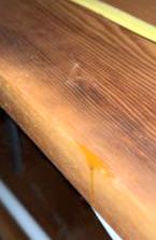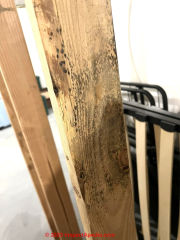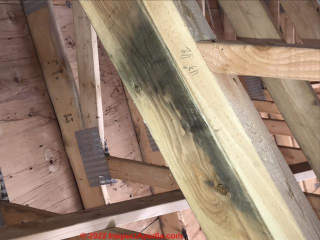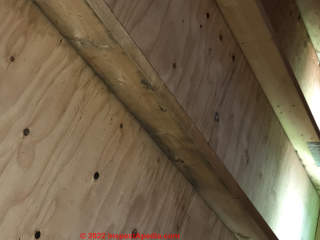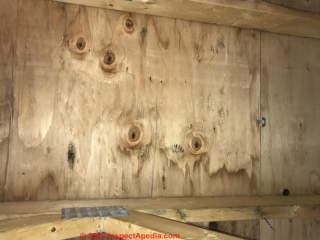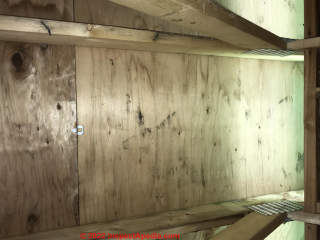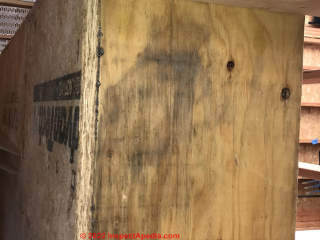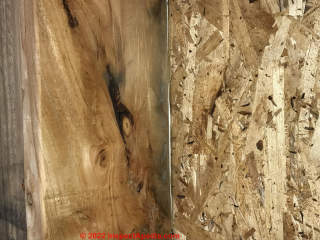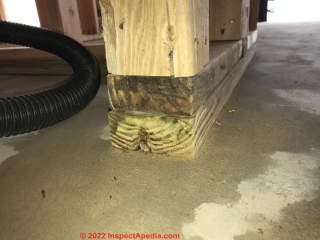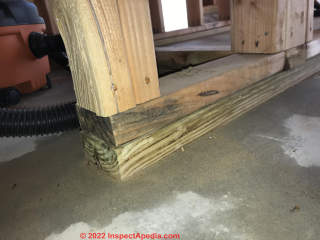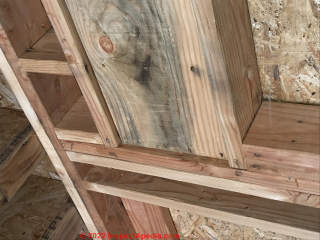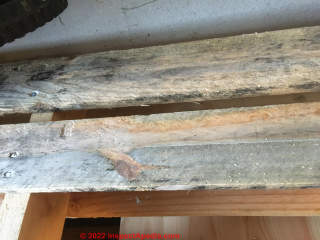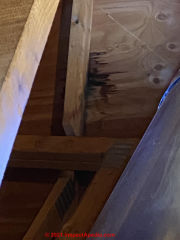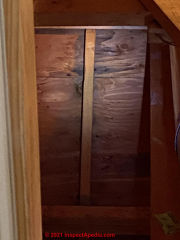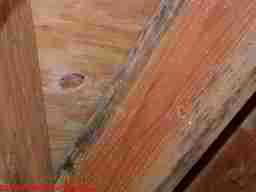 Harmless "Cosmetic" Mold in Buildings
Harmless "Cosmetic" Mold in Buildings
- POST a QUESTION or COMMENT about how to spot harmless or cosmetic black mold in buildings
Cosmetic mold generally does not need to be tested nor removed.
How can we recognize harmless mold indoors? Don't spend a fortune on needless cleaning of cosmetic-only mold growth.
This article discusses how to recognize mold that may be harmless, or cosmetic only in importance in buildings. We look for mold in buildings not only where mold is visible but also by context: where do we see leak stains, or where do we see building practices most likely to have produced a hidden leak or moisture problem?
We also discuss: age of mold: how to determine that mold has not been actively growing on building framing. How to tell, with confidence that black mold you see on building framing or other wood surfaces is old, came in with the lumber from the lumber yard, and is a cosmetic stain fungus.
InspectAPedia tolerates no conflicts of interest. We have no relationship with advertisers, products, or services discussed at this website.
- Daniel Friedman, Publisher/Editor/Author - See WHO ARE WE?
How to Recognize Harmless Cosmetic Molds and Other Low-Risk Molds
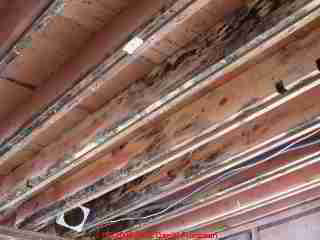
Cosmetic-only Ceratocystis/Ophistoma bluestain mold is shown on the floor joists in the new construction framing in the photo just above.
This is a harmless, cosmetic-only mold that does not damage the lumber and is not a pathogen for humans. Here's a good example of the observation that not all "black mold" is "toxic black mold". It will be totally hidden when the ceiling drywall is installed.
The mold shown in the photograph above is plain to see during construction, but will be covered and hidden completely when the contractor installs the ceiling drywall.
One of our clients discovered this scary-looking black mold during a renovation and was quite concerned that a major toxic black mold reservoir had been found in the building.
He client was facing a very costly mold cleanup project if this mold had to be addressed as a toxic material. Luckily this was not the case in this instance, as was easily demonstrated both by a simple inexpensive lab test and confirmed by onsite inspection of other framing details discussed at "Cosmetic Molds" linked-below.
So sometimes the mold in your house might be only a cosmetic concern.
"Bluestain" or Ceratocystis/Ophistoma is common on framing lumber and we often find it in attics on the under side of roof sheathing. Unless it's in finished portions of living space where it creates a cosmetic problem, no particular action needed to address this black mold.
Detailed advice about spotting harmless black mold including how to determine by visual inspection
alone whether or not you're probably looking at one of these common framing lumber cosmetic molds
is
Warning notice about Cleaning Up Mold Yourself
Guidelines defining what's a "large amount" of mold and what's reasonable for a
homeowner to handle have been published by several states including New
York and California. Links to some key documents describing mold cleanup and mold remediation procedures
are
at MOLD CLEANUP GUIDE- HOW TO GET RID OF MOLD
People who are allergic, asthmatic, infant, elderly, immune-impaired, etc., should not disturb mold and should not be in the area where mold remediation is being performed. Consult with your doctor, health department or other professional before tackling this job yourself.
On occasion some visible mold can be determined to be harmless and "cosmetic" old mold that was present when the building was constructed.
While it is always possible that additional more harmful molds are present in addition to the cosmetic mold, if there is no leak history nor any other evidence of mold growth in a building and if there are no health or building-related occupant complaints, the identification of the cosmetic mold described here might be accomplished by visual inspection alone, saving on more costly professional mold tests.
The distinction between harmful and harmless mold in attics or under roofs is discussed further
at ATTIC MOLD, HARMLESS COSMETIC?
...
Reader Comments, Questions & Answers About The Article Above
Below you will find questions and answers previously posted on this page at its page bottom reader comment box.
Reader Q&A - also see RECOMMENDED ARTICLES & FAQs
On 2024-01-08 by Anthony - is this bad mold in my basement?
My wood in the basement is having drastic things eating away at it
On 2024-01-08 by InspectApedia Publisher
@Anthony,
The photo is a bit small, Anthony and I can't see something "eating" at the wood;
Is this a framing member such as a floor joist or something else?
Are you referring to that dark, almost black material (maybe mold?)
Here are some things to check:
COSMETIC MOLD, RECOGNIZE https://inspectapedia.com/mold/Cosmetic_Mold.php
MOLD APPEARANCE - WHAT MOLD LOOKS LIKE https://inspectapedia.com/mold/Mold-Recognition-Guide.php
INSECT INFESTATION / DAMAGE https://inspectapedia.com/structure/Insect_Damage.php
Please post follow-up questions or photos on any of those topic pages - for a quicker, more-complete reply as well as to invite help from others familiar with those topics and questions.[Ed. note: this question and response was originally posted on a different nonrelevant page]
On 2023-11-29 by Mold - what's the black stuff on this stud?
Hello! This stud looked weird when i bought the house but i don’t think there were quite so many black dots. Inspector suggested encapsulating it. Would it be better to remove the whole stud? Or should clean it before encapsulating?
The idea of covering it with paint (albeit fungicidal) makes me leery. There’s a baby in the house so want this problem gone. Prior owner may have had a flood issue. She passed so no way to know for sure
On 2023-11-29 by InspectApedia Publisher - moldy wood framing doesn't necessarily need replacement
@Mold,
It would be very unusual to need to replace wood framing simply because it's moldy. As long as it's not rotted or damaged you can leave it in place. But clean it before applying any sealant.
Use the on page search box to find our article about
COSMETIC BLACK MOLD before deciding just how much cleaning and ceiling are needed here.[this reader question and our response was originally posted on our Contact page]
On 2022-07-19 by Kristin - black mold on framing during construction of a new home
 We are constructing a new home and, thanks to supply chain delays, the framing sat exposed to rain for a couple of months before the roof was able to be sealed in. We are still waiting on windows which have been delayed. (Framing was finished in Feb).
We are constructing a new home and, thanks to supply chain delays, the framing sat exposed to rain for a couple of months before the roof was able to be sealed in. We are still waiting on windows which have been delayed. (Framing was finished in Feb).
I’m now seeing areas on the plywood, joists, etc that appear to be black mold, and I’m thinking they are likely cosmetic mold based on your articles, but I’m concerned we’re dealing with other possible species? Do we test, treat, or just leave it? Hire a professional to take a look?
The house will hopefully be windowed in next month. We were thinking of renting some dehumidifiers to try to get out any residual moisture, then treat the areas before the windows arrive and insulation goes in, but now I’m wondering if that’s overkill.
(We’re moving from a currently very moldy home, and I’m paranoid about this new house having the same problem!) Thanks!
On 2022-07-19 by InspectApedia-911 (mod)
@Kristin,
If it was the Cosmetic mold that's described in these Pages it would have come in on the lumber at the time that it was first delivered to the building site and would have been visible from initial time of construction. So if that's not the case and the mold growth is new and more recent than you probably want to clean it.
Look closely at the areas of the structure that sat wet, particularly areas that would dry out slowly such as underside of plywood subfloors, and look among what might be cosmetic mold on framing to see if other colors of mold are growing.
It's much cheaper now to spray clean and dry those areas now than to have to tear something apart later.
On 2022-07-22 by Kristin - lots of photos of black mold on plywood, trusses, studs in new construction
@InspectApedia-911,
...
...
...
On 2022-07-22 by InspectApedia-911 (mod) - new construction framing exposed to rain is not just cosmetic mold
@Kristin,
Your photographs show that there were leaks through the roof shaving from above, that large areas of plywood have become moldy, it's not cosmetic mold that came in on the framing lumber.It would make sense to clean this before completing construction of the building as it's much easier to clean before insulation and drywall and other materials have been installed below.
On 2022-04-12 by Riou - two moldy pallets in the garage - I'm SO WORRIED
Hello and thank you for your help. During our construction two years ago we put two pallets in the garage, I found the bottom of them as on the picture, should I worry (I do not know if it was present at the beginning)?
The garage is a bit damp since some leather shoes had started to get moldy. Is my whole garage contaminated by spores? Aude Riou
On 2022-04-12 by Inspectapedia Com Moderator - get rid of moldy pallets and leather shoes
@Riou,
On one can say with certainty what old is in your garage from just a photo and brief text, but it's worth noting that you're seeing wet conditions and moldy shoes in that space, so there could certainly be other mold contamination besides the shoes and the pallets.
You might want to toss those pallets and the moldy shoes, then find the source of water, see what got wet, inspect for mold.
On 2022-04-12 by Riou
Thanks for your response, I was hoping it was just cosmetic mold on the palette. I think the shoes have started to mold because this winter we had very humid air and the garage is not ventilated enough.
On 2022-04-12 by Inspectapedia Com Moderator -The Wise Lady from Philadelphia
@Riou,
The Wise Lady from Philadelphia says rather than worry (which is bad for your health) - throw those things out.The total likely health hazard from a bit of mold on two wood pallets isn't worth losing sleep over - just toss them out and let it go.
On 2022-04-12 by riou - I'm afraid that every object in my garage is contaminated and I don't dare touch anything,
thank you for your patience, indeed I can't sleep anymore, I'm afraid that every object in my garage is contaminated and I don't dare touch anything, so I'll throw it away
On 2022-04-12 by Inspectapedia Com Moderator
@riou,
The worry itself is more likely to be the more serious health hazard.
If you are really frightened and are about to throw out stuff that may be perfectly harmless, perhaps its time to hire an inspector - not someone to simply "test"
On 2021-04-18 by Gena - what to do about black stains in attic in a house for sale
House for sale and inspected and the person took pictures of black “stains” in our attic. It doesn’t really look like any pictures I’ve seen in this article. They are implying roof leak. So we are waiting for official report but not sure what to do so any advice would be appreciative.
On 2021-04-18 - by (mod) -
@Gena, Sure, post some sharp photos - one per comment, but as many comments and photos as you need.
be sure to also read ATTIC MOLD https://inspectapedia.com/mold/Attic_Mold_Contamination.php
On 2021-04-18 by Gena
Here are more photos of stains in my attic - on the underside of the roof
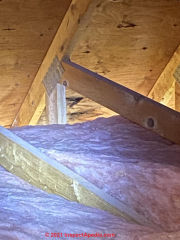
...
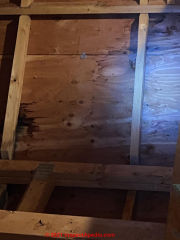
On 2021-04-18 - by (mod) - leak stains on roof underside mean look for cause, mold, ceiling damage, insulation contamination
@Gena,
In your FIRST that's a leak stain - near the ridge
If that's the only stain there is no significant risk of mold contamination from just that small area; the size of the area is trivial from a mold-contamination or cleanup view.
in an abundance of caution the area would be cleaned and if you like sprayed with a clear sealant to improve its moisture and thus mold resistance.
The roof needs inspection to identify and fix the leak. And if I were the inspector I'd examine the insulation below and the attic side of the ceiling drywall below to be sure there's no water nor mold damage.
Watch out: your other photos show multiple leak areas - the whole roof needs a more-careful inspection and diagnosis for leaks, age, condition, etc. and the areas below those leaks needs investigation as I described just above.
Don't panic, none of this is unusual;
On 2021-04-18 by Gena
Thank you. It’s only 16 years old and we have a call in to a roofer for a free estimate. The drywall on that side of attic in the house has no stains at all. Thank you again for your quick reply.
I posted but days needs approval.
On 2021-04-18 - by (mod) -
@Gena,
That's all encouraging but to be sure we are on the same page what do you want to check is the attic side of the ceiling drywall seams or inspected from in the Attic by lifting the insulation under areas where there are leak stains.If the attic side of the ceiling drywall is clean and dry and mold free then the scope of work needed is considerably less.
On 2021-03-01 by Daisy - old stains on wooden headboard
I purchased a recycled timber bed head 4 years ago and only after recent googling did I notice that there may be mould growing on it. Can someone shed some light on what it may be please?
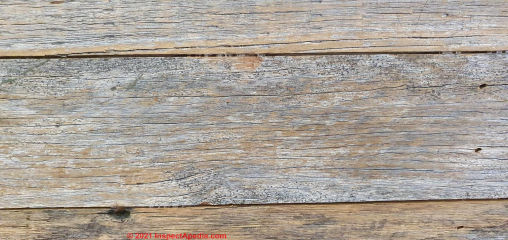
On 2021-03-01 - by (mod) -
@Daisy, it looks like mold stained wood, I agree. It could also of course be oxidized if it was in fact we're that was left exposed to sunlight. I can't quite distinguished from Sister photo. However it also looks as if the wood has been coated with a clear sealant.
If that's true it's not likely that there's any active mold growing so as to release of spores into the room air.
To be thorough you should also check that the back and sides have been sealed.
On 2020-09-28 by Jody - black goo and stains on floor joists in cellar
I found this black goo on the floor joists con my cellar. No idea what it is but it’s thick and tarry and dripped on the cellar floor. No water pipes anywhere near this black gunk. My son in law said it has a urine like odor
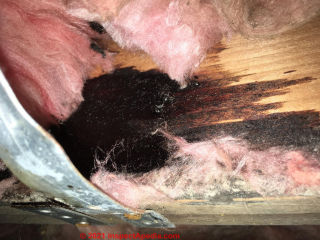
On 2020-09-28 - by (mod) -
That's indeed odd; the dark brown marks bleeding along the wood grain tell us that this was a liquid; is it possible there were animals nesting in the insulation?
Another possibility is a water leak in the walls, leaching out asphalt from building paper behind siding.
I'd pull all of the insulation out in that area. Wear a mask etc as you may be dealing with mouse, rat or other rodent fecals and urine and bacterial hazards.
On 2017-12-13 by Anonymous - Can mold be on a plastered ceiling?
Can mold be on a plastered ceiling? There is a shadow following the edge of the 2X6 in one section of the kitchen?
On 2017-12-14 by (mod) -
Yes, anon.
Plaster is less mold-friendly than gypsum board because the plaster is more alkaline. But mold may love growing on paint on plaster and I have found some mold growth in plaster that has been wet.
But to diagnose a shadow, search InspectApedia for THERMAL TRACKING and take a look at those stain patterns.
Question: soft tiny gray spots land on screen and keyboard.
(Nov 21, 2014) Robert Mc said:
70 year old house. Small office. Period of few months, soft tiny gray spots land on screen and keyboard. It wipes off easily but comes back, almost like very fine dust and disappears in the cloth. A/C vent tapped off. What could it be?
Thanks.
Reply:
Could be common house dust: a mixture of fabric fibers and skin cells. Or if there is an unusual particle source that'd be it. To identify the particles you'd want to send a tape sample of the dust to a forensic lab. (Not to us).
See inspectapedia.com/sickhouse/Adhesive_Tape_Particle_Test.php
...
Continue reading at BLACK MOLD, HARMLESS or select a topic from the closely-related articles below, or see the complete ARTICLE INDEX.
Or see these
Recommended Articles
- BLACK MOLD, HARMLESS
- COSMETIC MOLD CLEANUP EXPENSE
- COSMETIC MOLD, RECOGNIZE - you are on this page
- MOLD APPEARANCE - WHAT MOLD LOOKS LIKE
- MOLD CONTAMINATION IN BUILDINGS - home
Suggested citation for this web page
COSMETIC MOLD, RECOGNIZE at InspectApedia.com - online encyclopedia of building & environmental inspection, testing, diagnosis, repair, & problem prevention advice.
Or see this
INDEX to RELATED ARTICLES: ARTICLE INDEX to MOLD CONTAMINATION & REMEDIATION
Or use the SEARCH BOX found below to Ask a Question or Search InspectApedia
Ask a Question or Search InspectApedia
Try the search box just below, or if you prefer, post a question or comment in the Comments box below and we will respond promptly.
Search the InspectApedia website
Note: appearance of your Comment below may be delayed: if your comment contains an image, photograph, web link, or text that looks to the software as if it might be a web link, your posting will appear after it has been approved by a moderator. Apologies for the delay.
Only one image can be added per comment but you can post as many comments, and therefore images, as you like.
You will not receive a notification when a response to your question has been posted.
Please bookmark this page to make it easy for you to check back for our response.
Our Comment Box is provided by Countable Web Productions countable.ca
Citations & References
In addition to any citations in the article above, a full list is available on request.
- Fifth Kingdom, Bryce Kendrick, ISBN13: 9781585100224, - we recommend the CD-ROM version of this book. This 3rd/edition is a compact but comprehensive encyclopedia of all things mycological. Every aspect of the fungi, from aflatoxin to zppspores, with an accessible blend of verve and wit. The 24 chapters are filled with up-to-date information of classification, yeast, lichens, spore dispersal, allergies, ecology, genetics, plant pathology, predatory fungi, biological control, mutualistic symbioses with animals and plants, fungi as food, food spoilage and mycotoxins.
- In addition to citations & references found in this article, see the research citations given at the end of the related articles found at our suggested
CONTINUE READING or RECOMMENDED ARTICLES.
- Carson, Dunlop & Associates Ltd., 120 Carlton Street Suite 407, Toronto ON M5A 4K2. Tel: (416) 964-9415 1-800-268-7070 Email: info@carsondunlop.com. Alan Carson is a past president of ASHI, the American Society of Home Inspectors.
Thanks to Alan Carson and Bob Dunlop, for permission for InspectAPedia to use text excerpts from The HOME REFERENCE BOOK - the Encyclopedia of Homes and to use illustrations from The ILLUSTRATED HOME .
Carson Dunlop Associates provides extensive home inspection education and report writing material. In gratitude we provide links to tsome Carson Dunlop Associates products and services.


